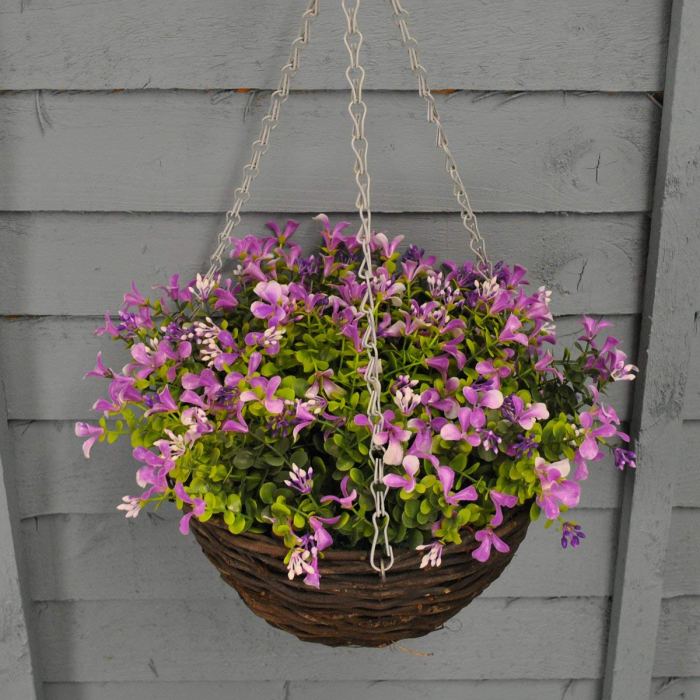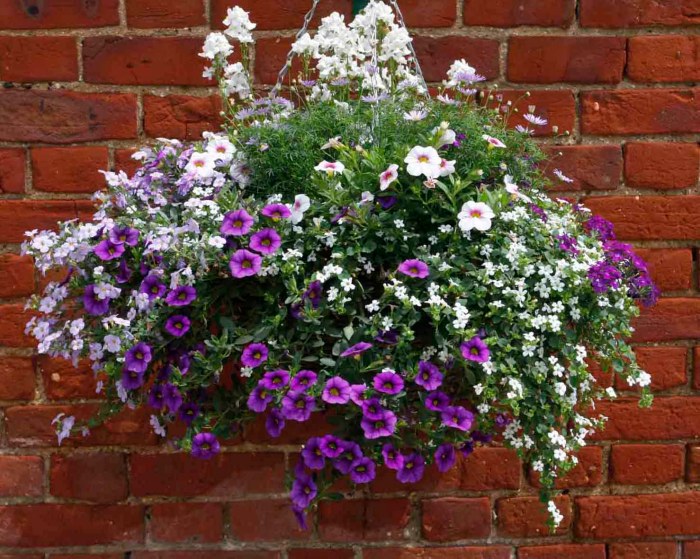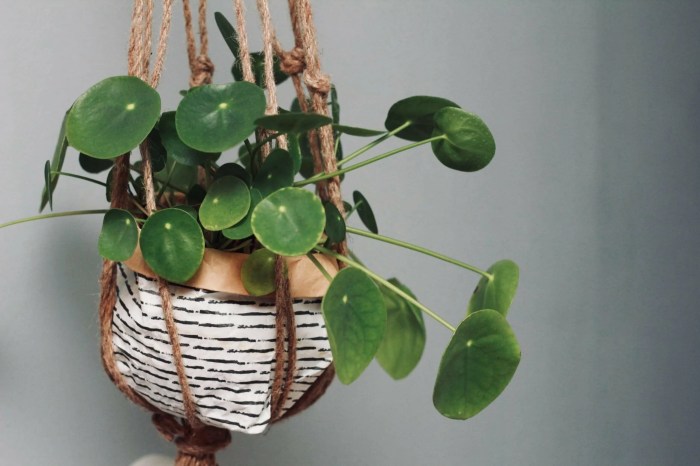Transform your living spaces with the best houseplants for hanging baskets. These verdant wonders not only add a touch of nature to your home but also purify the air and enhance well-being. From cascading ferns to trailing succulents, discover the perfect plants to elevate your indoor decor.
When selecting houseplants for hanging baskets, consider factors such as light requirements, water tolerance, and growth habit. Choose from a wide range of options, including:
Identifying Suitable Plants

Selecting the right houseplants for hanging baskets requires careful consideration of factors such as light requirements, water tolerance, and growth habit. Plants that thrive in hanging baskets typically have trailing or cascading foliage that can gracefully drape over the sides, creating a visually appealing display.
Some of the most popular and suitable houseplants for hanging baskets include:
Trailing Plants, Best houseplants for hanging baskets
- Spider Plant (Chlorophytum comosum): Known for its long, variegated leaves that produce spiderettes, which can be propagated into new plants.
- String of Pearls (Senecio rowleyanus): Features succulent, pea-shaped leaves that resemble a string of pearls.
- Burro’s Tail (Sedum morganianum): Characterized by plump, trailing leaves that resemble a donkey’s tail.
Cascading Plants
- Peperomia (Peperomia spp.): Comes in various species with variegated or heart-shaped leaves, adding a touch of color and texture to hanging baskets.
- Golden Pothos (Epipremnum aureum): A popular choice with heart-shaped leaves that cascade beautifully.
- Philodendron (Philodendron spp.): Offers a wide range of species with trailing or cascading leaves, such as the Heartleaf Philodendron and the Swiss Cheese Plant.
Hanging Basket Selection and Care
Hanging baskets are a great way to add greenery and style to your home. They’re perfect for small spaces or for adding a touch of nature to any room. But before you go out and buy a hanging basket, it’s important to do your research and choose the right one for your needs.
Types of Hanging Baskets
There are many different types of hanging baskets available, each with its own advantages and disadvantages. Here are a few of the most popular types:
- Wire basketsare lightweight and durable, making them a good choice for outdoor use. They’re also relatively inexpensive, so they’re a good option for budget-minded shoppers.
- Macrame basketsare made from woven cord or twine. They’re lightweight and stylish, but they’re not as durable as wire baskets. Macrame baskets are best suited for indoor use.
- Ceramic basketsare heavy and durable, but they’re also more expensive than other types of baskets. Ceramic baskets are a good choice for outdoor use, but they can also be used indoors.
- Plastic basketsare lightweight and inexpensive, but they’re not as durable as other types of baskets. Plastic baskets are best suited for indoor use.
Preparing and Planting Hanging Baskets
Once you’ve chosen a hanging basket, it’s time to prepare it for planting. Here are the steps:
- Line the basket with a liner.A liner will help to prevent soil from falling out of the basket and will also help to keep the soil moist.
- Add a layer of gravel to the bottom of the basket.This will help to improve drainage.
- Fill the basket with potting mix.Use a potting mix that is specifically designed for container gardening.
- Plant your plants in the basket.Be sure to space the plants evenly and to plant them at the correct depth.
- Water the plants thoroughly.
- Protect the baskets from the wind.Wind can damage the plants and can also cause the baskets to swing, which can be dangerous.
- Bring the baskets indoors during the winter months.Most houseplants are not cold-hardy and will need to be protected from the cold weather.
- Repot the plants every few years.As the plants grow, they will need to be repotted into larger baskets.
- Vertical Gardens:Create a living wall with hanging baskets filled with lush ferns, trailing vines, and flowering plants.
- Floral Cascades:Suspend baskets filled with cascading flowers such as petunias, impatiens, or lobelia for a dramatic effect.
- Edible Gardens:Grow your own herbs, strawberries, or small vegetables in hanging baskets for a functional and decorative touch.
- Fairy Gardens:Create a whimsical fairy garden with miniature plants, figurines, and accessories in small hanging baskets.
- Terrariums:Enclose miniature landscapes in glass or plastic hanging baskets to create a unique and self-sustaining ecosystem.
Watering and Fertilizing Hanging Baskets
Hanging baskets need to be watered regularly, especially during the hot summer months. Water the plants until the water drains out of the bottom of the basket. Fertilize the plants monthly with a balanced fertilizer.
Best houseplants for hanging baskets are not limited to the usual choices of ferns and ivies. More unusual plants like Tillandsia, which doesn’t require any soil and gets all its nutrients from the air, can also thrive in a hanging basket.
For more plant varieties that can add a touch of greenery to your home, visit Plants . A variety of hanging plants are available to suit any home décor and provide an easy way to add life to a room.
General Care for Hanging Baskets
In addition to watering and fertilizing, hanging baskets need to be given some general care. Here are a few tips:
Aesthetic Considerations

Hanging baskets offer a delightful way to add visual interest and greenery to indoor and outdoor spaces. By carefully considering principles of visual appeal, you can create stunning arrangements that enhance the ambiance of your surroundings.
Color Combinations: Experiment with vibrant color combinations to create eye-catching displays. Consider contrasting colors, such as red and green, or complementary colors, such as blue and orange, for a dynamic effect. Alternatively, opt for a monochromatic scheme using different shades of the same color to create a cohesive look.
When searching for the best houseplants for hanging baskets, consider beautiful trailing indoor plants such as spider plants , pothos , and string of pearls . These plants add a touch of greenery and elegance to any room, and their trailing stems create a cascading effect that is perfect for hanging baskets.
Plant Placement:
Arrange plants in a way that balances the visual weight of the basket. Place larger, fuller plants in the center and smaller, trailing plants around the edges to create a cascading effect. Consider the growth habits of each plant to ensure they have ample space to thrive.
Cascading Effects:
Incorporate trailing plants, such as ivy or ferns, to create a sense of movement and fluidity. Allow their stems to cascade over the edges of the basket, adding a touch of elegance and drama to the display. Use different lengths and textures of trailing plants to create visual interest.
By considering these aesthetic principles, you can design hanging basket arrangements that are both visually appealing and tailored to your personal style and the specific space they occupy.
Maintenance and Troubleshooting

Maintaining hanging basket plants requires attention to specific issues that arise due to their elevated placement. Common problems include overwatering, underwatering, root rot, and pest infestations. This section provides practical solutions to address these challenges, ensuring the health and beauty of hanging basket plants.
Regular maintenance practices, such as pruning, repotting, and pest control, are essential for optimal plant growth. This guide offers techniques for each of these tasks, empowering plant enthusiasts to proactively care for their hanging basket plants.
Pruning
Pruning involves removing dead, diseased, or overgrown stems and leaves to promote healthy growth. Regular pruning prevents overcrowding, improves air circulation, and encourages new growth. Use sharp, clean shears to make precise cuts, and avoid over-pruning, as this can weaken the plant.
Repotting
Repotting becomes necessary when the plant outgrows its current container or when the soil becomes depleted. Choose a new pot that is slightly larger than the previous one and provides adequate drainage holes. Use a well-draining potting mix and carefully transfer the plant, ensuring that the roots are not damaged.
Water thoroughly after repotting and monitor the plant closely for any signs of stress.
Pest and Disease Control
Hanging basket plants are susceptible to various pests and diseases, including aphids, mealybugs, and fungal infections. Early detection and treatment are crucial to prevent severe damage. Use organic methods such as insecticidal soap or neem oil to control pests. For fungal diseases, remove affected leaves and treat the plant with an appropriate fungicide.
Best houseplants for hanging baskets are a great way to add a touch of greenery to your home. From trailing vines to cascading ferns, there are many different types of plants that can be used in hanging baskets. For a more dramatic effect, consider choosing best cascading house plants . These plants have long, flowing stems that can create a beautiful waterfall effect.
Some of the best cascading houseplants for hanging baskets include spider plants, pothos, and wandering jew.
Regular inspection and prompt action can effectively manage pest and disease issues.
For a stunning vertical display, consider incorporating hanging baskets into your indoor greenery. From lush ferns to trailing vines, the best houseplants for hanging baskets offer a wide array of textures and colors. If your hanging baskets are destined for a spot with ample natural light, explore the best hanging plants for high light to find varieties that will thrive in these conditions.
From the vibrant blooms of begonias to the delicate foliage of maidenhair ferns, these plants will create a captivating display in any room.
Troubleshooting Guide
To assist plant enthusiasts in identifying and resolving specific problems, a comprehensive troubleshooting guide is provided. This guide covers common issues such as yellowing leaves, stunted growth, and wilting. By following the recommended steps, plant owners can diagnose and address issues promptly, ensuring the well-being of their hanging basket plants.
Inspiration and Design Ideas

Hanging baskets offer endless opportunities for creativity and design. Whether you’re a seasoned gardener or a beginner, there are countless ways to create stunning arrangements that will add a touch of beauty to your home or outdoor space.
From cascading greenery to vibrant blooms, hanging baskets can be used to create a variety of looks. Here are some inspiring examples and design ideas to get you started:
Hanging Basket Arrangements
Final Wrap-Up: Best Houseplants For Hanging Baskets

Hanging baskets provide endless opportunities to create stunning indoor and outdoor displays. Experiment with different plant combinations, colors, and cascading effects to achieve a captivating visual impact. Whether you’re a seasoned plant enthusiast or a novice gardener, this guide will empower you to cultivate thriving houseplants in hanging baskets, bringing beauty and tranquility to your surroundings.
FAQ
Which houseplants are best suited for hanging baskets?
Trailing plants such as pothos, spider plants, and ferns are ideal for hanging baskets due to their cascading growth habit.
How do I prepare a hanging basket for planting?
Line the basket with sphagnum moss or a commercial liner, add a well-draining potting mix, and ensure proper drainage holes.
How often should I water houseplants in hanging baskets?
Water when the top inch of soil feels dry to the touch, allowing excess water to drain freely.